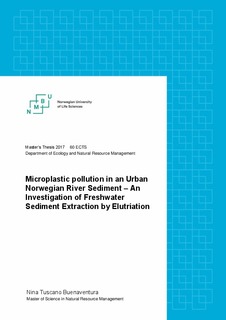| dc.description.abstract | Plastic materials in the environment are the most conspicuous and easily recognisable litter that are of great concern all over the world, including Norway. As these plastic debris continuously break up to even smaller pieces such as microplastics, they become more easily distributed to terrestrial, marine and freshwater environments. These microplastics (< 5 mm) are of great concern due to their long degradation time and that they can accumulate in habitats and be ingested by organisms. The effects of microplastics in the different environments and its effects on organisms are still not well known. Thus, the presence or absence of microplastic pollution is of pressing need specifically were data is lacking, in rivers and terrestrial environments.
Six sediment samples were taken along an urban Norwegian river in Oslo, Akers River to quantify microplastics in freshwater sediment. The first sample was taken at the mouth of a preserved lake, Maridal and the rest of the samples were taken further downstream where the river eventually enters the city of Oslo. There are however currently no standardised techniques for sampling or quantifying microplastics from sediments. Nonetheless, based on Claessens et al (2013) elutriation device (ED) to extract microplastics from marine sediments, freshwater sediments were used for the same purpose. Elutriation is a technique where the upward water flow and gas in a column is used to separate lighter from heavier particles, causing the lighter particles to float and exit the ED. Heavier particles will thus sink and be retained. The polymers used to spike the standardised artificial and natural sediments were virgin plastic pellets of high-density polyethylene (HDPE), low-density polyethylene (LDPE), polypropylene (PP), polycarbonate (PC), polyethylene terephthalate (PET) and polystyrene (PS). Both types of sediments were elutriated by the ED and the experiments showed that the aeration intensity was ideal at low (20 L min-1), and the run time set to 25 minutes. Water flow was at 300 L h-1 and pre-determined by Claessens et al (2013). HDPE, LDPE and PP had a100 % recovery rate, PET and PC were not extracted while PS had a maximum recovery rate of 85 %. From these results, it was expected to extract light plastics such as HDPE, LDPE, PP and some PS from Aker River sediments.
Microplastics of both light and heavy plastics in Akers River sediment were found. Polymers with densities ≥ 1.0 g cm-1 may not however all be extracted, or not extracted at all from samples as elutriation was shown to be strongly density-dependent. Due to time limitations only Site 1 (all three subsamples) and Site 6 (one subsample) underwent FT-IR analysis. At Site 1, six plastic particles were found, and at Site 6 a total of 101 plastic particles. Of the total 107 plastics identified, polyurethane (PUR) was the most common plastic found followed by polyethylene (PE), polyvinyl-alcohol (PVA), acrylics and poly(methyl methacrylate) (PMMA). The two polymers PUR and acrylics were mostly associated with paint fragments which coincides with literature reporting that microplastics from paint is the second most common microplastic pollution found in Norway. Furthermore, many of the plastic types found in Akers River are also consistent with what other studies have found in other freshwater environments. | nb_NO |

